Dan Worrall
There is something fascinating about a century-old image of someone playing a concertina. Perhaps the reason is that so many of us play concertinas that are themselves a century old, or close to it. The mind wanders while playing an old waltz, and one wonders if that waltz had been played on his or her concertina before. Here are a few old images that have crossed my desk in recent years.
The earliest photographs and images of Irish (and English/American) concertina playing
For some time, I had thought that the image on the cover of my 2009 social history of the Anglo-German concertina (see Figure 1) was the oldest known photograph of Irish concertina playing. That image, from a potato harvest in Athea, Co. Limerick, in 1911, shows a woman named May Nan Stevens holding a two-row German concertina of the type widely played in rural Ireland in the nineteenth and early twentieth centuries.
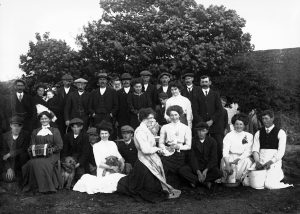
That photograph appears to have been staged. Ms. Stevens, according to a resident of that town, was not known to play the concertina, and indeed the photograph shows that she is holding the instrument upside down, as the air button is misplaced and rests below her pinky finger.1 This photograph was taken toward the end of the instrument’s early period of popularity in Ireland, no doubt with nostalgic intent, and thus is imperfect as a photographic record of actual use of the instrument. There are two earlier known drawings of Irish concertina players—one at a dance in a police barracks in 1887, and another in a painting of a Drogheda street scene of 1880.2 But are there Irish photographs that predate the 1911 photo?
An older Irish image has indeed emerged, although the photograph was taken in South Africa rather than in Ireland. Irish volunteers on the side of the Boers were active in the bitterly fought Anglo-Boer War. An Irish Brigade was formed in 1899 in Johannesburg, which included local Irish immigrants as well as recruits from Ireland itself and a smattering of Irish-Americans. A photograph taken of that brigade shows the unit’s concertina player at the center of the image (Figure 2). His name is unknown, but he is holding a German concertina. The Brigade’s leader was an American West Point graduate, John Young Filmore Blake (1856-1907), pictured second from the left of the concertina player. The brigade was known for using dynamite to blow up bridges and British supply trains; some members were mine workers and well versed in how to use dynamite.3 Perhaps the most well-known member of that unit today would be John McBride (1868-1916), later executed for his part in the 1916 Easter Uprising in Dublin. Assuming that the soldier holding the concertina was himself Irish-born, this appears to be the oldest known photograph of the German concertina associated with Ireland.
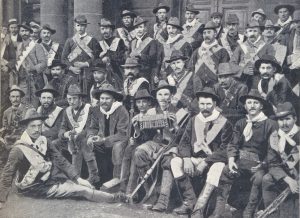
But it is not the oldest known photograph of a concertina being played in Ireland. That distinction—for now at least—goes to a photograph of Frances Judith Grove (nee Montgomery) of Castlegrove estate in Donegal, which was sent to me by Elizabeth Goell of Omagh, Co. Armagh, a classically trained soprano who found the photograph while researching an old piano that had once belonged to Clara Schumann but had ended up with that Donegal family.4 The photograph (Figure 3) was taken by F. H. Mares in Dublin, who was a photographer active between 1862 and 1875. The instrument that Ms. Grove is playing is an English concertina with wooden fretwork. Such instruments, of course, were popular with the landed gentry of that time, like the Montgomery and Grove families in Donegal. It is likely that its use here was for parlor music, as suggested by the setting of the photograph, rather than for the polkas and waltzes for which the German concertinas were concurrently being hammered by rural folk. Nonetheless, this image takes the cake as the oldest known (to me) photograph of an Irish concertina player.
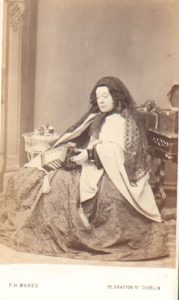
Which brings up a question: what is the earliest image of an English player of the concertina? The oldest to my knowledge is an image of young David Edward Hughes playing a Wheatstone English concertina (Figure 4), drawn in or about 1841. It was not drawn in England, however, but rather was sketched in America, to which the Hughes family had emigrated from England in 1840. David Edward Hughes (1831-1900) was not only a musician (in his younger days), but was a prodigious inventor, responsible for the telegraph printer (telex), carbon microphone, induction balance (metal detector), and—some think—the mobile telephone. I wrote of him at length in Papers of the International Concertina Association (PICA, 4 [2007]). As a ten-year-old, Hughes travelled around America with his family, eking out a living as itinerant classical musicians. In the PICA article, I had only the central part of this drawing, showing David Hughes and his concertina, but subsequently a correspondent (whose name escapes me) sent me the entire image shown in Figure 4 and including his brothers Joseph and John who are standing on tables while playing violin and harp. From Wheatstone’s ledgers, we know that David Hughes’ father purchased the instrument from the Wheatstone Company in 1836.5
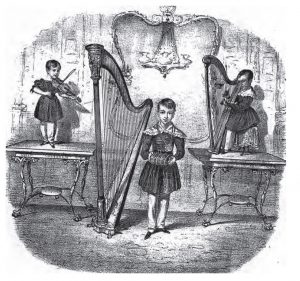
It seems a bit odd that no other images of people playing the concertina in the 1830s seem to exist. So what is the oldest photograph of a concertina and its player in England? I have a candidate or two, but there may be other candidates known to readers. Please send your prospective images along with documentation to me via this publication, and soon we will discover who has the oldest image.
Minstrels and music halls in England
There are many postings of images of the concertina’s use on the English music stage. Here are two of special note. Figure 5 depicts the earliest such concertina image to my knowledge—that of a “Coloured Opera Troupe” entertaining an audience at an Oxford Street gallery in London—from the Illustrated London News of November 13, 1858. The concertina player, a Mr. Wile, is seated at second from the right. This group reportedly was a long-term nightly fixture at that gallery, during a time when American minstrel shows were all the rage not only in England, but in Ireland, South Africa, and Australia. They performed their antics in blackface, which would be completely beyond the pale today, but was then thought to be a necessary part of the fun. As reported,
These gentlemen work well together, and appear to equal each other in spirit, activity, resources, talent, and love of fun. Nothing can be more silly and absurd than these negro-rhymes, the imperfections of which reckon among their attractions, a false rhyme taking the rank of a positive beauty. Yet out all this nonsense, modulated as it is by the cunning of these minstrels’ art, there somehow rises a humanizing influence which gives to an innocent recreation a positive philanthropic sentiment. This sentiment connects itself with them as a colored troupe. With white faces the whole affair would be intolerable. It is the ebony that gives the due and needful colour to the monstrosities, the breaches of decorum, the exaggerations of feeling, and the “silly, sooth” character of the whole implied drama. Some of the instrumental music is marvelous. Mr. Wile’s military solo on the concertina commanded tremendous applause….
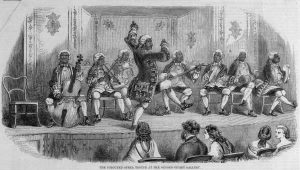
Such blackface minstrelsy and its comic antics became a well-loved fixture of the British and American stage for many decades, not only in cities but in the countryside. Early twentieth century photographs of the Manningham Concertina Band (near Cleckheaton in Yorkshire), collected by Neil Wayne on his Concertina Museum website, show blackfaced Anglo concertina players in garish costumes, an obvious take on the minstrels.
The concertina also appeared in whiteface troupes, such as the group depicted in Figure 6. This show featured Pierrot-garbed whiteface pantomimes, two of whom play concertinas. This was a rather bittersweet occasion, as the audience was comprised of British and Indian troops during World War I. They were being entertained at an undisclosed location in France near the front line in 1915, within the sound of the guns. As described by the Illustrated London News of February 6, 1915,
The men-performers on mandolin, banjo, and concertina were all “Tommies,” and two local ladies helped them by dancing with no little alacrity. Costumes were made by a good-natured local dressmaker; a motor-lorry supplied electric-light for the schoolroom in which the show was held, and “deserted” houses supplied the chairs. The “Tommies,” shaking with laughter at the Fragson and other drolleries and the quaint step-dances, found a curious contrast in the imperturbable Indians, who watched the entertainment as gravely as though they were taking part in some solemn ceremonial. Of such are the strange contrasts of this wonderful war! In the trenches, suffering and death; two miles away, the lively entertainment we illustrate.
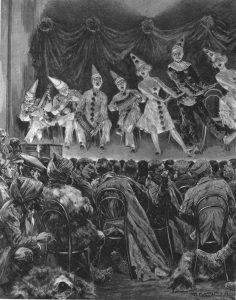
The concertina was commonly used on the English stage well into the twentieth century, as the following image (Figure 7) from the Illustrated London News of March 5, 1932 indicates. Here the thespians are garbed as costers in all their pearled finery in the musical “Derby Day.” As usual, the lead performer had the concertina. The barmaid-heroine (played by Tessa Deane) is shown leading a chorus with her concertina, which appears to be an Anglo.
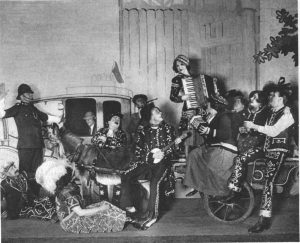
An invitation
Do you have some historic old images of concertina players, which have not seen the light of day? Write a brief note for this section, and tell us about them.
- Dan Worrall, The Anglo German Concertina, A Social History, Vol. 1 (Fulshear, TX: Concertina Press, 2009) 210-211, and personal communication with Sean O’Dwyer. Online version of The Anglo German Concertina, Vol. 1 and Vol. 2, are at Google Books.
- Worrall, The Anglo German Concertina, Vol. 1, 205 and 208.
- Marthinuis Van Bart, “Irish volunteers fighting for freedom in the Anglo-Boer War,” 2011; online at http://newhistory.co.za/history-of-south-africa-2/
- See https://www.galwayartscentre.ie/en/clara-schumann-s-piano-in-ireland
- Wheatstone sales ledger 104a Wayne Archive (London: Horniman Museum), p.5. The sales entry is for Wheatstone concertina No. 100. The ledgers are online at http://www.horniman.info/.